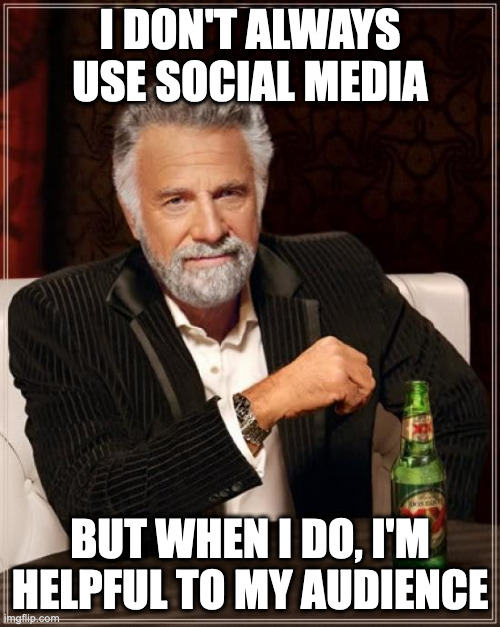There are plenty of insights and data on the internet about social media and how social is increasing every company’s revenue goals by “1 trillion dollars,” or how the population is running to every social platform by the “gajillions.”
We should all be on social as soon as we can and start posting every day, every minute, every second! Right?
Wrong!
The true power of social media is influence. Social provides an avenue for companies to not only engage with customers, but also influence them with the right content that helps them make a decision.
How social media has power
There is plenty of research showing social media’s growing impact on people, communication, and society.
For instance, Pew Research Center reports most U.S. adults use Youtube, with Facebook cited as the second-most network – with Tik Tok, Instagram, and SnapChat highly-used for adults under the age of 30.
Globally, Smart Insights shows over 57% use at least one form of social media – with many using it for news.
So right away, there’s power in numbers – the vast numbers of people who engage equates to a lot of influence in how algorithms shape people’s online interactions and what they view / read. This also shapes people’s opinions and feelings on current events, hot topics, etc.
Is that good, bad, or neither?
It depends.
The American Psychological Association reports different studies showing minimal impact on people’s in-person interactions due to increased / decreased social media usage.
Meanwhile, in a study published in the American Academy of Pediatrics, clear benefits and risks of social media are outlined for teens, such as:
- Benefit: People feeling more authentic online as their interactions more closely reflect their real-life engagements
- Benefit: Ability to make new friends
- Benefit: Ability to self-discover as teens “test” new ideas
- Risk: The prevalence of cyber-bullying
- Risk: Late-night use of social media leading to negatively-impacted sleep cycles, which hurts many developments
- Risk: Exposure to advertisers on for-profit platforms
The debate around fact-checking was also brought more into the limelight in 2020 due to the COVID-19 pandemic, but as Harvard’s Kennedy School showed, support is varied.
Put it all together, and you get studies such as this one saying “64% of Americans say social media have a mostly negative effect on the way things are going in the U.S. today.”
It’s indisputable, however, that social networks have a vast amount of influence – and thus, plenty of power. It’s how this is used that generates lots of debate, but as people and companies, we have to acknowledge the reality of just how much its ingrained into everyday life.
how should companies view this?
Social media allows businesses to build connections with prospects and customers in a more direct way, including customer service and inviting users to show ways they use a company’s product / service.
If you believe in being customer-centric, then you have to be where your audience spends time and engages … and for most, no matter if it’s a Fortune 500 or a small business, your audience is on at least 1 or 2 social channels.
But knowing which channels are right for you to invest in? That’s the key. Just because TikTok is insanely popular doesn’t mean that’s where your sales and marketing efforts will bear the most fruit.
Making yourself more available to your audience in the places they choose to spend their time, with the proper infrastructure in place (i.e. somebody managing your channels, escalation processes for specific questions or events, etc.), can absolutely be a value-add as marketing grows the company’s brand among its target audience.
Related: Map the right customer journey for your ideal customer
Companies often get leverage social media poorly (+what to do instead)
The problem is many companies still view social media as something that’s an add-on instead of a vital investment, despite evidence showing its a great way to grow customer lifetime value and drive more brand loyalty.
Instead, these companies are:
- Reposting the same content across social every channel
- Not using the appropriate voice for the social platform
- Asking for likes
- Posting only conversion posts: i.e. Fill out this form to download <insert piece of content>
- Lacking a social strategy that aligns with the marketing strategy
- Using every social channel out there
Let’s address the pitfalls of each of these individually. And, don’t forget to read our revenue marketing deep dive, which helps you think through social media (and all marketing) and pull it into a more revenue-focused approach!
Reposting the same exact content across social channels
Why this doesn’t work: This isn’t effective because each social network is different. The audience is different, so therefore the delivery should be different. Each social network has a different layout and process you have to follow to ensure your post gets maximum reach.
What you should change: Approach each social network as a brand new tool rather than lumping them all together. Optimize your voice and content to match the user-base of the social platform.
Remember, you’re trying to relate to the people on the platform – they were there without you, so you need to prove your worth to them.
Not using the appropriate voice for the social platform
Why this doesn’t work: Having a company voice that doesn’t match the platform will hinder your social interactions, and this includes having too formal of a voice. People are not leads on social networks – they are people!
What you should change: Remember to have fun and interact through memes, pictures, or even casual conversation as appropriate. Change your tone to match the social platform you’re on.
You can post a formal company-focused post on LinkedIn, but keep it casual on Facebook, short and simple on Twitter, and more lighthearted (and visual) on Instagram. (And of course, you can see how we do it here at The Pedowitz Group on our own social media channels!)
Asking for likes

Why this doesn’t work: Asking for likes is the social equivalent of asking for a compliment. If something works, or a post reaches a set audience that engages or likes the post, they will come and like your page (or even better, share it!)
What you should change: Changing your outward social strategy to match the unique social platforms will help your followers not only like what you post, but also share it and help increase your reach.
There are also other ways to “ask” for likes, without coming right out and posting a status about it. For example: if someone likes your Facebook post, you can “Invite” them to like your page. This is a great tool to convert post likes into page likes.
You also should not be measuring success on this vanity metric. Use Engagements within the social channel, and website analytics (such as pages / session and conversion rates) to see how people interact with your site when they decide to take the next step.
This also allows you to better-test what content is received well by your audience – both on the channel, and also on the website.
Posting only conversion-focused posts
Why this doesn’t work: Marketing is everywhere! But you can’t simply ask people for their info without the “relational right” of earning their trust.
You can see tactics being adopted across multiple brands and multiple channels. People are very cautious about submitting their information. Simply posting assets or links to blog posts and expecting people to engage probably isn’t the best strategy.
What you should change: Share other posts and industry information while keeping it fun and social! As Seth Godin puts it, build a tribe of followers and relate to them. Invite users to showcase their own content, and highlight them.
It’s not all about you. In fact, it’s not really about you at all – it’s about your customer.
Lacking a social strategy that aligns with the marketing strategy
Why this doesn’t work: Social shouldn’t be separated from marketing.
If you’ve ever found yourself saying, “Yeah, let’s put that on Twitter and Facebook,” that means you treat social as an afterthought. Planning is the most crucial part of any marketing campaign, and if you aren’t highlighting social’s strengths, you may not have a full grasp of your customer’s journey.
This allows us to build a strong foundation and also set requirements of what we want the results to be. A strategy helps define what is considered success.
What you should change: Involve social just as you would any other channel: inbound, outbound, 3rd party sender etc. Always include social media and set aside the budget needed to run a social ad or promote via social. If the budget or time doesn’t allow for it, then it’s ok to bypass just like you would another tactic.
Social presents a unique opportunity to interact with fans of your brand, or find new people who haven’t heard about you just yet.
Related: Marketing Operations consulting that streamlines your team, processes, and more
Using every social channel out there
Why this doesn’t work: While being involved in social is always good, spreading yourself too thin is not. Just because there are multiple social networks to choose from, doesn’t mean you should use them all.
What you should change: Try one or two at first and then slowly expand to other social networks. Or, don’t! Go where your audience is involved. Analyze your social networks, look at the ones producing the most engagement and focus more attention on those.
There are great audience research tools out there (such as Sparktoro) which can help identify how your audience spends its time online.
If LinkedIn or Twitter is not your audience’s medium of engagement, then don’t spend effort or time on it. You want to focus what’s working and then slowly expand. Get a firm foothold on one social network and how you need to be interacting with your followers there before moving to the next.
Ignoring social selling
This plays into the two previous points, but is worth mentioning on its own.
With any sales process that involves a sales team, there’s always the need to vett a prospect and better understand who they are. LinkedIn, Facebook, Twitter, etc. all play into this.
And this is where social selling comes into play.
Social selling is “build rapport with a network of potential leads” per Hootsuite, and this is an excellent definition because you’re not always selling.

You’re networking!
Why ignoring this doesn’t work: In many industries, and especially B2B, people buy from people. Engaging on social allows you to become a trusted part of a prospect (or customer) network that makes it easier to get a productive conversation later.
What to do instead: Spend 15 minutes a day commenting on people’s posts. Make sure to be part of active conversations in groups that pertain to what you offer.
Build trust!
Then, your face / name will engender trust, and you’ll have more of a rapport to be able to inquire about specific pains and potentially uncover sales opportunities.
Related: Lead management consulting services that take all of your channels into account
Closing Thoughts
We tend to forget the ‘social’ part of social media marketing and tend to focus on the marketing part. There are no leads or prospects on social networks, just people.
Some might like goofy cat pictures or “The Most Interesting Man In The World” memes, but mainly they are people that are trying to take a break from their crazy life and relax for a second before moving onto the next meeting or the next email.
Leverage the power of social media and its ability to create influence to build trust in your brand, connect with other people, and ultimately make it easier to sell!
Like this content? You’ll also love this article explaining what revenue marketing is.
